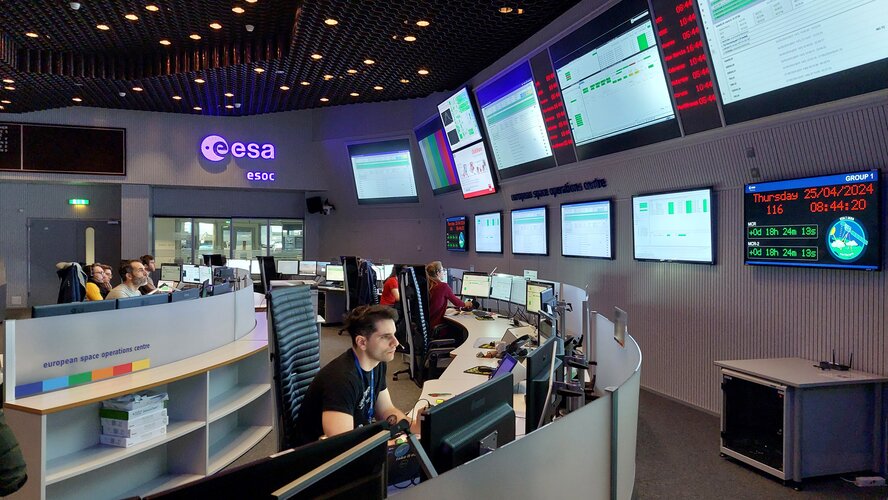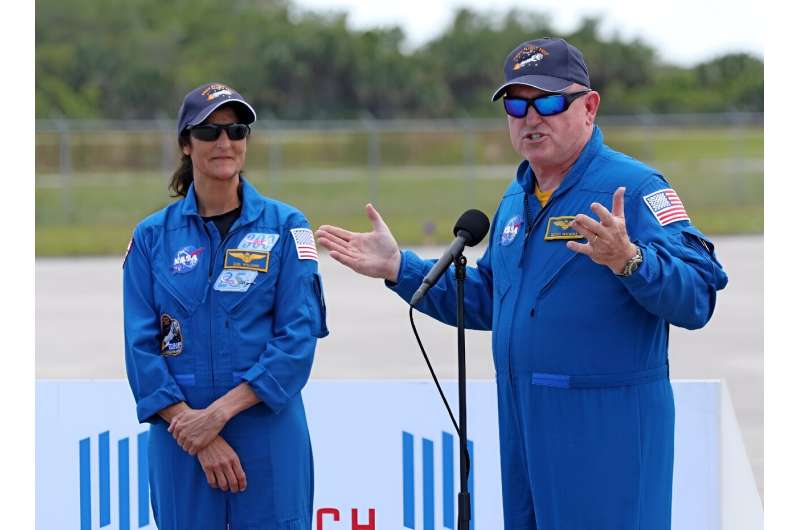Mission control ready for EarthCARE despite disruption
Monday, 06 May 2024 07:00
Teams at ESA’s European Space Operations Centre in Darmstadt, Germany, are currently engaged in intensive preparations for the critical ‘Launch and Early Orbit’ phase of the agency's EarthCARE satellite.
Radioisotope thermoradiative cells: advancing power generation for outer planet missions
Sunday, 05 May 2024 17:57 Continuing from Phase I, researchers are expanding on the development of a power source that transforms the paradigm of thermal power conversion. The thermoradiative cell (TRC), operating analogously to a solar cell but in reverse, converts heat from a radioisotope source into infrared light, which is then emitted into space, generating electricity. Initial studies demonstrated a potential gener
Continuing from Phase I, researchers are expanding on the development of a power source that transforms the paradigm of thermal power conversion. The thermoradiative cell (TRC), operating analogously to a solar cell but in reverse, converts heat from a radioisotope source into infrared light, which is then emitted into space, generating electricity. Initial studies demonstrated a potential gener OneNav introduces new L5-direct GNSS receiver in response to increased GPS jamming
Sunday, 05 May 2024 17:57 oneNav, a developer of global navigation satellite system (GNSS) technology, has launched L5-direct, a GNSS product capable of directly acquiring and tracking L5-band signals. This innovation arrives amid growing concerns over Russian forces using GPS jamming techniques in Europe to impair American drones in Ukraine.
In March 2024, over 1,600 civilian aircraft in Eastern Europe experienced
oneNav, a developer of global navigation satellite system (GNSS) technology, has launched L5-direct, a GNSS product capable of directly acquiring and tracking L5-band signals. This innovation arrives amid growing concerns over Russian forces using GPS jamming techniques in Europe to impair American drones in Ukraine.
In March 2024, over 1,600 civilian aircraft in Eastern Europe experienced Unraveling the diet of white dwarfs: New insights into their metal consumption
Sunday, 05 May 2024 16:38 White dwarfs, remnants of stars like the Sun, pack a mass equivalent to the Sun's but are as small as Earth, making up 97% of our galaxy's stars. The transformation of a star into this dense state marks the stellar lifecycle's end, rendering our galaxy a celestial necropolis.
The chemical composition of white dwarfs, especially the unexpected presence of heavy metals like silicon, magnesiu
White dwarfs, remnants of stars like the Sun, pack a mass equivalent to the Sun's but are as small as Earth, making up 97% of our galaxy's stars. The transformation of a star into this dense state marks the stellar lifecycle's end, rendering our galaxy a celestial necropolis.
The chemical composition of white dwarfs, especially the unexpected presence of heavy metals like silicon, magnesiu Seeds from China's space station tested in agricultural experiments
Sunday, 05 May 2024 16:38 Following the recent return of the Shenzhou-17 spacecraft, seeds that experienced space radiation for nearly a year aboard China's space station have arrived back on Earth. These seeds are now part of critical breeding experiments.
The seeds, including alfalfa and oats, were exposed to space radiation on the space station's biology exposure equipment for 11 months, provided by the Lanzhou
Following the recent return of the Shenzhou-17 spacecraft, seeds that experienced space radiation for nearly a year aboard China's space station have arrived back on Earth. These seeds are now part of critical breeding experiments.
The seeds, including alfalfa and oats, were exposed to space radiation on the space station's biology exposure equipment for 11 months, provided by the Lanzhou NASA launches commercial studies to facilitate Mars robotic science
Sunday, 05 May 2024 16:38 NASA has commissioned 12 concept studies from nine U.S. companies to explore how commercial services could support scientific missions to Mars. These studies, funded between $200,000 and $300,000 each, will investigate various services including payload delivery, communications relay, surface imaging, and payload hosting to aid future missions to Mars.
The initiative began with a request f
NASA has commissioned 12 concept studies from nine U.S. companies to explore how commercial services could support scientific missions to Mars. These studies, funded between $200,000 and $300,000 each, will investigate various services including payload delivery, communications relay, surface imaging, and payload hosting to aid future missions to Mars.
The initiative began with a request f Revisiting gravity: University of Waterloo researchers propose new model for cosmic anomalies
Sunday, 05 May 2024 16:38 Researchers from the University of Waterloo, in collaboration with the University of British Columbia, have observed what they term a "cosmic glitch," indicating a deviation in gravity's behavior on a vast cosmic scale.
For a century, Albert Einstein's theory of general relativity has been the cornerstone of our understanding of gravity, asserting its influence across not just three physic
Researchers from the University of Waterloo, in collaboration with the University of British Columbia, have observed what they term a "cosmic glitch," indicating a deviation in gravity's behavior on a vast cosmic scale.
For a century, Albert Einstein's theory of general relativity has been the cornerstone of our understanding of gravity, asserting its influence across not just three physic A Fluidic Telescope is enabling the Next Generation of Large Space Observatories
Sunday, 05 May 2024 16:38 The future of space-based UV/optical/IR astronomy requires ever larger telescopes. The highest priority astrophysics targets, including Earth-like exoplanets, first generation stars, and early galaxies, are all extremely faint, which presents an ongoing challenge for current missions and is the opportunity space for next generation telescopes: larger telescopes are the primary way to address thi
The future of space-based UV/optical/IR astronomy requires ever larger telescopes. The highest priority astrophysics targets, including Earth-like exoplanets, first generation stars, and early galaxies, are all extremely faint, which presents an ongoing challenge for current missions and is the opportunity space for next generation telescopes: larger telescopes are the primary way to address thi Testing the quantumness of gravity without entanglement
Sunday, 05 May 2024 16:38 Gravity, a fundamental force in our everyday lives, continues to puzzle scientists: Is it a geometric force as Einstein suggested, or does it follow quantum mechanics? Researchers from the University of Amsterdam and Ulm have introduced an innovative experiment to explore this, avoiding the challenges of previous methods that required entangling massive objects, which often lose their quantum pr
Gravity, a fundamental force in our everyday lives, continues to puzzle scientists: Is it a geometric force as Einstein suggested, or does it follow quantum mechanics? Researchers from the University of Amsterdam and Ulm have introduced an innovative experiment to explore this, avoiding the challenges of previous methods that required entangling massive objects, which often lose their quantum pr Mars agriculture simulations show promise and challenges
Sunday, 05 May 2024 16:38 The vision of a permanent human settlement on Mars is drawing closer to reality, and with it, the challenge of ensuring food security for Martian colonists. The reliance on Earth for resupplying food is both impractical and costly, making it imperative to utilize Martian resources for local food production.
Rovers have initially scoped Martian terrains, setting the stage for human research
The vision of a permanent human settlement on Mars is drawing closer to reality, and with it, the challenge of ensuring food security for Martian colonists. The reliance on Earth for resupplying food is both impractical and costly, making it imperative to utilize Martian resources for local food production.
Rovers have initially scoped Martian terrains, setting the stage for human research Lunar railway initiative aims to streamline moonbase logistics
Sunday, 05 May 2024 16:38 NASA is advancing plans for the first lunar railway system, described as a critical component for the daily operations of a sustainable lunar base envisioned for the 2030s. This initiative is part of NASA's broader Moon to Mars plan, which includes mission concepts like the Robotic Lunar Surface Operations 2 (RLSO2).
"We want to build the first lunar railway system, which will provide reli
NASA is advancing plans for the first lunar railway system, described as a critical component for the daily operations of a sustainable lunar base envisioned for the 2030s. This initiative is part of NASA's broader Moon to Mars plan, which includes mission concepts like the Robotic Lunar Surface Operations 2 (RLSO2).
"We want to build the first lunar railway system, which will provide reli EarthCARE satellite set for launch
Sunday, 05 May 2024 16:38 Recently, ESA's EarthCARE satellite was removed from its transport container at Vandenberg Space Force Base, California, beginning an intensive period of preparation for its upcoming launch. The team conducted detailed inspections and testing to ensure the satellite was in optimal condition for its mission.
Ensuring the cleanliness of EarthCARE was a critical step in optimizing the perform
Recently, ESA's EarthCARE satellite was removed from its transport container at Vandenberg Space Force Base, California, beginning an intensive period of preparation for its upcoming launch. The team conducted detailed inspections and testing to ensure the satellite was in optimal condition for its mission.
Ensuring the cleanliness of EarthCARE was a critical step in optimizing the perform SpaceX reveals EVA suit design as Polaris Dawn mission approaches
Sunday, 05 May 2024 01:40

Boeing's Starliner finally ready for first crewed mission
Saturday, 04 May 2024 07:18
Launch day is finally here: Boeing's Starliner capsule blasts off Monday to the International Space Station on its first crewed mission—several years after SpaceX first achieved the same milestone.
The flight, a final test before Starliner takes up regular service for NASA, is critical for the US aerospace giant, whose reputation has suffered of late due to safety issues with some of its passenger jets.
Starliner, which was first ordered a decade ago by the US space agency, has had a bumpy ride to the finish line, with surprise setbacks and multiple delays—a saga Boeing is eager to complete.
Astronauts Butch Wilmore and Suni Williams are set to leave Cape Canaveral at 10:34 pm Monday (0234 GMT Tuesday) aboard the capsule.



